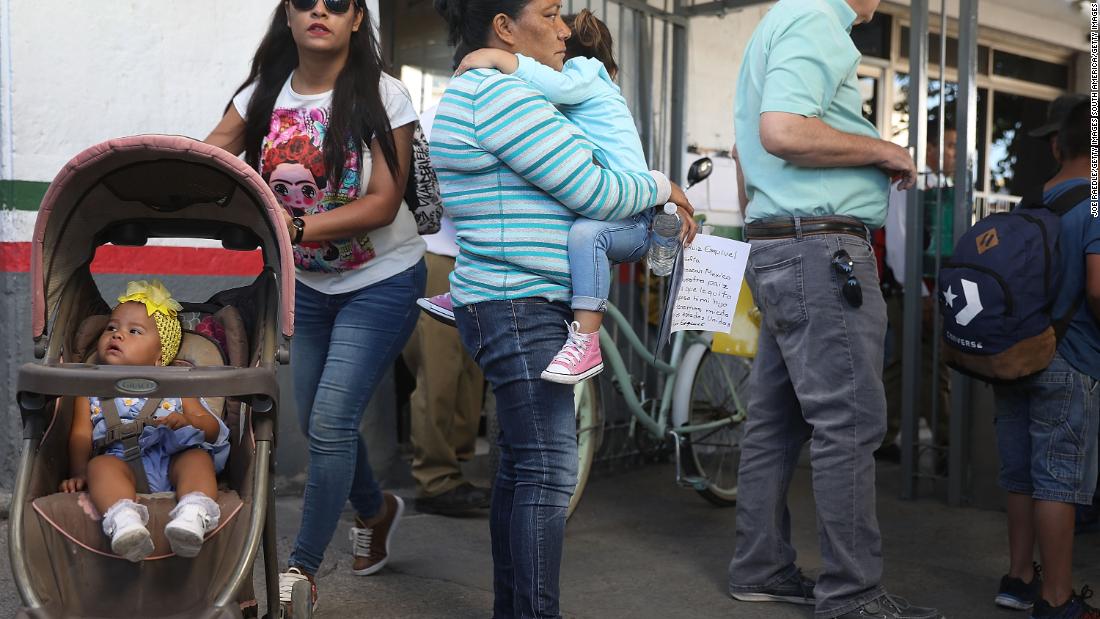[ad_1]
But officials might need additional time to track down dozens of parents who are no longer in custody — including 19 who were already deported, Justice Department attorney Sarah Fabian said in court Friday.
US District Judge Dana Sabraw didn’t offer officials any extensions at Friday’s hearing, saying he needed more information on the cases. Sabraw said the government must provide a list by 5 p.m. Saturday of all the children in the group and any reasons officials believe they may need more time for reunions in particular cases. Court will reconvene on Monday.
“What I’m expecting is a lot of work over the weekend,” he said.
19 parents already deported
Friday’s hearing was the latest in an American Civil Liberties Union lawsuit over the administration’s family separations. The case includes a broader group of thousands of other children and parents, but the hearing focused largely on the pressing deadline for children under 5.
The Justice Department attorney provided the most detailed description officials have released so far about this particular group of immigrant children who were separated from their parents. Of the roughly 100 kids, Fabian said:
• 83 kids have been linked to 86 parents.
• 16 kids have not yet been linked with parents.
• 46 of those parents remain in the custody of Immigration and Customs Enforcement.
• 19 of those parents have been released from ICE custody.
• 19 of those parents have been removed from the United States.
• Two of the parents have criminal histories that will prevent officials from reuniting them with their children.
Fabian said officials should have no problem reuniting children and parents who remain in custody. But it’s more challenging to reunite kids with parents who’ve been released from ICE custody, she said.
“If we’re not aware of where the parent is, I can’t commit to saying that reunification will occur before the deadline. … We’re still determining what the situation is there,” she said, “and whether those are situations where reunifications may not be able to occur within the time frame.”
After the hearing, ACLU attorney Lee Gelernt said it was troubling that officials still can’t provide precise statistics about families they separated.
“It was clear today that the government has not even been able to match all the children with parents,” he said. “That is extremely troubling.”
Debate over deportation
Several key issues came up in Friday’s court hearing: whether the government is going overboard in conducting tests to confirm parent-child relationships, and whether the judge’s order also applied to parents who’d been deported.
Fabian argued the judge’s order didn’t apply to parents who had been removed. Gelernt countered that it did.
“I think in some ways those are the most acute situations, the most horrible situations, because then you have a parent far away wondering, ‘Where is my child? What’s happening to this child?’ ” Gelernt said.
The judge said parents who’d been deported were included in his ruling.
Officials haven’t provided statistics on how many parents were separated from their children and deported without them.
Fabian said Friday that officials have been marshaling “significant resources” as they work to comply with the court order.
But she said their efficiency is hampered by requirements in the Trafficking Victims Protection Reauthorization Act, which sets out requirements officials have to follow when they release children into someone’s custody.
It’s one reason, she said, why officials are taking such painstaking steps to confirm parent-child relationships using methods that include DNA testing.
In a court filing before Friday’s hearing, the Justice Department asked if the court would permit reunifications outside of the ordered timelines “in cases where parentage cannot be confirmed quickly.” Sabraw appeared open to considering an extension in some cases Friday, but said he needed more information.
He noted that the act was intended for a different situation, but also said the government raised an important point.
Gelernt argued the government does not have to follow such “lengthy, cumbersome procedures” to reunite separated families.
“It just doesn’t make sense,” he said. “You’ve taken a child from the parent. They need to give the child back.”
“It shouldn’t be done in every case,” Gelernt said. “But if it is being done in every case, we would ask that it be used only for reunification and then expunged, because I don’t know that we want to be creating a database of all these people.”
HHS releases new estimate
Health and Human Services Secretary Alex Azar released a new estimate Thursday that fewer than 3,000 children remained in their care who could have been separated from their parents, but he said analysis was ongoing and he could not provide a more precise figure. The high number of families separated has been a result of the Trump administration’s “zero-tolerance” policy, which criminally prosecutes any adult crossing the southern border illegally.
The Health and Human Services Department has said the agency must determine that a “parent is not ‘unfit or presents a danger to the child,’ ” which means the agency must also have “an independent finding that the individual has not engaged in any activity that would indicate a potential risk to the child,” before reunification.
The agency’s court filing contained a description of steps undertaken by HHS to comply with the court order, including deploying 115 additional personnel to the field and contracting with 100 reunification managers who are deploying Friday and Saturday.
The agency said it has expedited its existing process for reunification.
HHS also claimed in the court documents that it “knows the names and locations of all children who are in (Office of Refugee Resettlement) care and custody at all times because ORR maintains that data in its online case management portal,” but says the portal was not designed to include certain details regarding the parents, which Department of Homeland Security may hold or the parent may have.
CNN’s Tammy Kupperman contributed to this report.
[ad_2]
Source link


